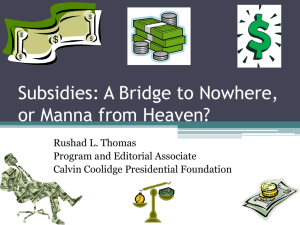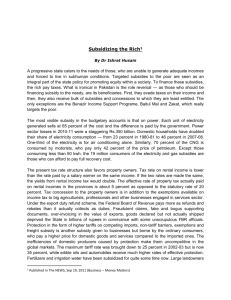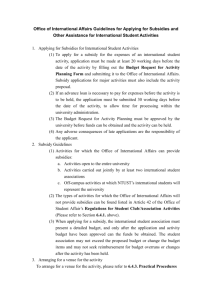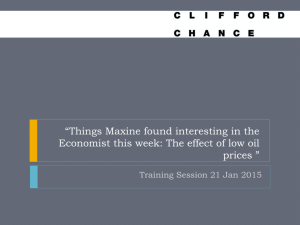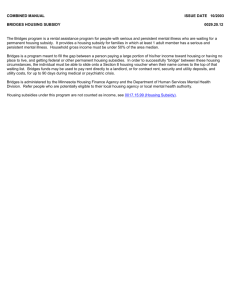SAA for WTO SCM Agreement
advertisement
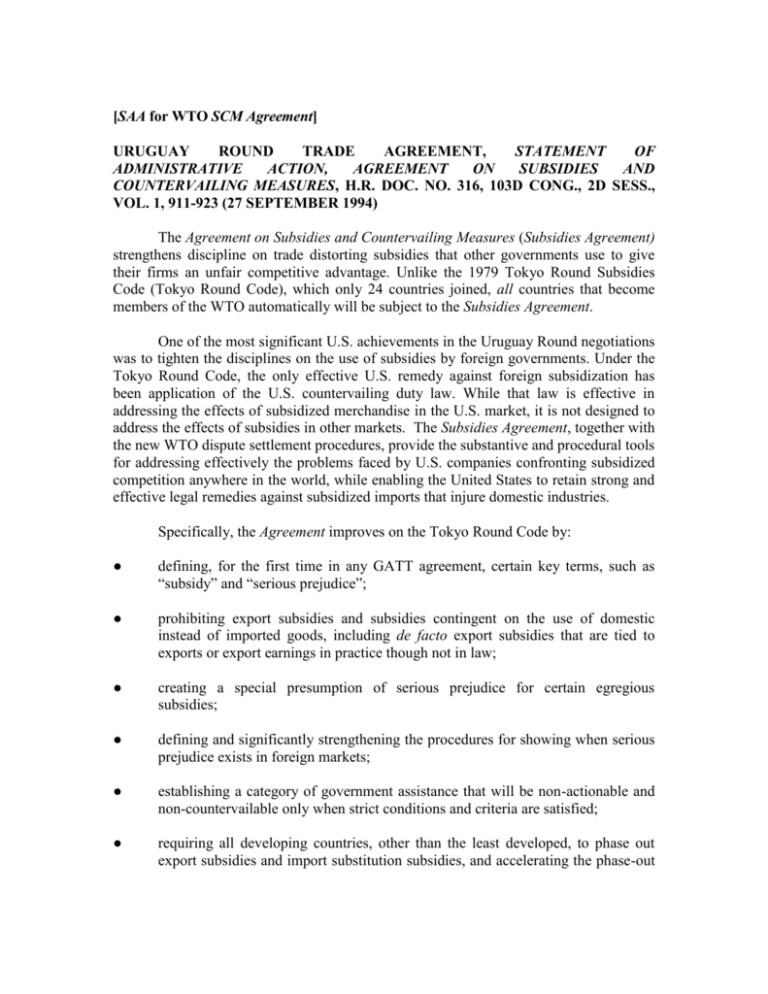
[SAA for WTO SCM Agreement] URUGUAY ROUND TRADE AGREEMENT, STATEMENT OF ADMINISTRATIVE ACTION, AGREEMENT ON SUBSIDIES AND COUNTERVAILING MEASURES, H.R. DOC. NO. 316, 103D CONG., 2D SESS., VOL. 1, 911-923 (27 SEPTEMBER 1994) The Agreement on Subsidies and Countervailing Measures (Subsidies Agreement) strengthens discipline on trade distorting subsidies that other governments use to give their firms an unfair competitive advantage. Unlike the 1979 Tokyo Round Subsidies Code (Tokyo Round Code), which only 24 countries joined, all countries that become members of the WTO automatically will be subject to the Subsidies Agreement. One of the most significant U.S. achievements in the Uruguay Round negotiations was to tighten the disciplines on the use of subsidies by foreign governments. Under the Tokyo Round Code, the only effective U.S. remedy against foreign subsidization has been application of the U.S. countervailing duty law. While that law is effective in addressing the effects of subsidized merchandise in the U.S. market, it is not designed to address the effects of subsidies in other markets. The Subsidies Agreement, together with the new WTO dispute settlement procedures, provide the substantive and procedural tools for addressing effectively the problems faced by U.S. companies confronting subsidized competition anywhere in the world, while enabling the United States to retain strong and effective legal remedies against subsidized imports that injure domestic industries. Specifically, the Agreement improves on the Tokyo Round Code by: ● defining, for the first time in any GATT agreement, certain key terms, such as “subsidy” and “serious prejudice”; ● prohibiting export subsidies and subsidies contingent on the use of domestic instead of imported goods, including de facto export subsidies that are tied to exports or export earnings in practice though not in law; ● creating a special presumption of serious prejudice for certain egregious subsidies; ● defining and significantly strengthening the procedures for showing when serious prejudice exists in foreign markets; ● establishing a category of government assistance that will be non-actionable and non-countervailable only when strict conditions and criteria are satisfied; ● requiring all developing countries, other than the least developed, to phase out export subsidies and import substitution subsidies, and accelerating the phase-out of export subsidies in situations where a developing country has achieved global export competitiveness in a particular product sector; and ● applying the rapid, effective WTO dispute settlement mechanism, which will end the present ability of the losing, subsidizing government to block the adoption of panel reports. 1. DEFINITION OF A SUBSIDY, SPECIFICITY The Subsidies Agreement begins by defining a subsidy. Article 1 requires two elements: (1) a “financial contribution by a government or any public body” within that government’s territory and (2) consequent conferral of “a benefit.” In order to be actionable either under WTO dispute settlement procedures or in a domestic countervailing duty (CVD) proceeding, a subsidy also must be “specific in accordance with the provisions of Article 2.” Article 1 specifies four categories of practices that constitute a financial contribution: (1) a direct transfer of funds (e.g., grants, loans, and equity infusions) or potential direct transfers of funds or liabilities (e.g., loan guarantees); (2) government revenue otherwise due that is foregone or not collected (e.g., fiscal incentives such as tax credits); (3) government provision of goods or services other than general infrastructure; and (4) government purchase of goods. Furthermore, Article 1 makes clear that a financial contribution can exist where, rather than acting directly, a government makes payments to a funding mechanism, or entrusts or directs a private body to carry out one or more of the type of functions described above, which normally would be vested in the government, and the practice, in no real sense, differs from practices normally followed by governments. Article 1 also provides that a subsidy includes any form of income or price support, which operates directly or indirectly to increase exports of any product from, or to reduce imports of any product into, the territory of a WTO member (see Article XVI:1 of GATT 1994). While Article 1 identifies the practices that constitute a “financial contribution,” it does not define “benefit” or set out criteria for measurement of whether a benefit is conferred, or its amount. Article 14 of the Agreement sets guidelines for methods used to calculate benefit. These guidelines follow the benefit-to-the-recipient methodology used in U.S. CVD proceedings. Article 14 explicitly equates the term “benefit” as used in Article I with application of the benefit-to-the-recipient methodology. (No other article draws a specific connection between “benefit” and a particular subsidy calculation methodology; the only other section of the Agreement that mandates a specific calculation methodology is Annex IV, which stipulates that the calculation of the total ad valorem subsidization of a product for purposes of the presumption of serious prejudice in Article 6.1(a) must be based on the cost to the government in providing the subsidy). 2 The guidelines set out in Article 14 are that: ● government provision of equity capital confers a benefit where the investment decision can be regarded as inconsistent with the usual investment practice (including that regarding the provision of risk capital) of private investors in that member’s territory; ● a loan by a government confers a benefit where there is a difference between the amount that the firm receiving the loan pays on that loan and the amount the firm would pay on a comparable commercial loan that the firm could actually obtain on the market, with the benefit equal to the difference between these two amounts; ● a loan guarantee by a government confers a benefit where there is a difference between the amount that the firm receiving the guarantee pays on that guaranteed loan and the amount that the firm would pay on a comparable commercial loan absent the government guarantee, with the benefit equal to the difference between these two amounts adjusted for any differences in fees; and ● the provision of goods or services, or the purchase of goods, by a government confers a benefit where the provision is made for less than adequate remuneration, or the purchase is made for more than adequate remuneration, with the adequacy of remuneration determined in relation to prevailing market conditions for the good or service in question in the country of provision or purchase (including price, quality, availability, marketability, transportation, and other conditions of purchase or sale). Article 2 provides that to be actionable a subsidy must be specific to “certain enterprises” (i.e., to an enterprise or industry or group of enterprises or industries within the jurisdiction of the granting authority). Consistent with longstanding U.S. practice, government assistance that is both generally available and widely and evenly distributed throughout the jurisdiction of the subsidizing authority is not an actionable subsidy. However, Article 2.1 makes clear that a subsidy is specific not only when the subsidy is limited to certain enterprises by law (de jure) but also where, despite the existence of neutral and objective eligibility criteria, the subsidy is provided in fact (de facto) only to certain enterprises. Notwithstanding the absence of de jure grounds for a finding of specificity, where there are reasons to believe that the subsidy may in fact be specific, other factors may be considered. They are: (1) the use of a subsidy program by a limited number of certain enterprises; (2) the predominant use by certain enterprises; (3) the grant of disproportionately large amounts to certain enterprises; and (4) the manner in which discretion has been exercised by the granting authority in the decision to grant a subsidy. In considering these four factors, the investigating authority is to take account of the diversification of economic activities within the relevant jurisdiction, as well as the 3 length of time that a subsidy program has been in operation. Article 2.4 requires that any determination of specificity be clearly substantiated on the basis of positive evidence. Under Article 2 all export subsidies and import substitution subsidies within the meaning of Article 3 of the Agreement are automatically deemed to be specific. Similar to longstanding U.S. CVD practice, the Agreement recognizes that subsidies granted by a state or province on a generally available basis within a state or province (i.e., not limited to certain enterprises within a state or province) are not specific, and therefore are not actionable. However, central government subsidies limited to a region (including a province or state) are specific, even if generally available throughout that region. 2. CLASSES OF SUBSIDIES Articles 3 to 9 of the [SCM] Agreement establish a three-class framework for the categorization of subsidies and subsidy remedies: (1) subsidies that are prohibited (the “red light” category); (2) subsidies that may be challenged in WTO dispute settlement proceedings and domestically countervailed if they cause adverse trade effects (the “yellow light” category, including “dark amber”); and (3) subsidies that are nonactionable and non-countervailable if they are structured according to criteria intended to limit their potential for causing trade distortions (the “green light” category). [This categorization is known as the “Traffic Light” system.] a. Prohibited (“Red Light”) Subsidies Article 3 lists subsidies that are prohibited under all circumstances. To challenge such a subsidy successfully in WTO dispute settlement proceedings, a complaining country need only prove that the subsidy exists; there is no need to demonstrate that the subsidy has had adverse trade effects. CVD action under domestic law also may be taken against prohibited subsidies, but an affirmative injury determination still must be made. Two types of subsidies are prohibited under Article 3: ● subsidies contingent, in law or in fact, whether solely or as one of several other conditions, on export performance; and ● subsidies contingent, whether solely or as one of several other conditions, on the use of domestic rather than imported goods. As compared to the Tokyo Round Code, the definition of prohibited subsidies significantly enhances subsidies discipline. It explicitly covers both de facto export subsidies and subsidies where export performance is but one of several criteria for eligibility. An illustrative list of export subsidies is set out in Annex I to the Subsidies Agreement. It is largely the same as the list included in the Tokyo Round Code…. 4 Article 28 permits WTO members to phase out prohibited subsidies that existed on April 15, 1994 (the date of signature of the Uruguay Round Final Act) within three years after the WTO Agreement enters into force if they notify the Subsidies Committee established under the Agreement of the existence of the subsidies in a timely manner. During the three-year period, these subsidies will not be prohibited outright. However, they will be actionable under either WTO dispute settlement procedures or domestic CVD proceedings if they are determined to cause adverse effects (injury or serious prejudice). Article 4 establishes expeditious procedures for resolving disputes concerning prohibited subsidies. All that must be established is the existence of a prohibited subsidy. If a panel or the Appellate Body finds that a government is maintaining a prohibited subsidy, the Dispute Settlement Body of the WTO (DSB) must authorize countermeasures if the subsidy is not withdrawn expeditiously. b. Actionable (“Yellow Light” and “Dark Amber”) Subsidies Article 5 sets out three types of adverse effects: ● injury to the domestic industry of another WTO member (the standard used in U.S. CVD proceedings); ● nullification or impairment of benefits accruing directly or indirectly to other WTO members (in particular, a country may not introduce or increase a subsidy that has the effect of negating the value of a tariff cut); and ● serious prejudice to the interests of another member. Serious prejudice applies with equal force and effect regardless of the market affected by the actionable subsidy (whether in an importing country, the subsidizing country, or a third-country market). Thus, it is the standard most often used to challenge subsidized competition in the subsidizing country or third-country markets. Unlike the Tokyo Round Code, Article 6 of the Agreement defines “serious prejudice.” This is a major improvement. The lack of criteria about serious prejudice in the Tokyo Round Code has been one of the major causes of the ineffectiveness of dispute settlement under that Code. Under the Agreement, a determination of serious prejudice must be based on measurable, verifiable data. Serious prejudice arises where the effect of a subsidy is manifested in: import displacement or impediment in either the subsidizing-country or third-country markets; significant price undercutting, significant price suppression, price depression or lost sales in any market; or an increase in world market share. Articles 6.4 through 6.6 provide more detailed guidance on the criteria set out in Article 6.3. They do 5 not, however, articulate any defenses to allegations of serious prejudice. (Such defenses are contained in Articles 6.7 and 6.8). Annex V to the Subsidies Agreement sets out detailed rules and procedures regarding the development of information concerning serious prejudice in dispute settlement proceedings. It permits a WTO dispute settlement panel to draw adverse inferences when any party does not cooperate. The Agreement refers to two kinds of actionable subsidies against which action can be taken in the WTO or in domestic CVD proceedings if adverse effects are established. The first type are those that are not otherwise dealt with by the Agreement as prohibited or non-actionable subsidies. The second (termed “dark amber” subsidies), listed in Article 6.1, are presumed to cause serious prejudice. Where serious prejudice is presumed, the burden is placed on the subsidizing government to demonstrate that serious prejudice did not result from the subsidization in question. The four “dark amber” subsidies are: ● total subsidization of a product exceeding five percent ad valorem, which is calculated in accordance with Annex IV on a cost-to-the-government basis; ● subsidies to cover operating losses sustained by an industry; ● subsidies to cover operating losses sustained by an enterprise other than one-time measures that are non-recurrent and cannot be repeated for that enterprise and that are given merely to provide time for the development of long-term solutions and to avoid acute social problems; and ● direct forgiveness of debt. … In addition to making improvements in the substantive rules applying to this class of subsidies, Article 7 and Annex V establish expeditious and effective procedures for resolving disputes regarding “dark amber” and “yellow light” subsidies. The procedures are virtually identical to those for other WTO dispute settlement proceedings. Once a member requests consultations regarding such a subsidy, the Agreement allots 180 days for completion of the panel proceedings and the issuance of a decision by the DSB. The Agreement provides an additional 60 days for appeals of panel findings. The losing party cannot block adoption of an adverse panel or Appellate Body report and the DSB must authorize countermeasures where a signatory has not either withdrawn a subsidy found to be causing serious prejudice or eliminated its adverse effects within six months. c. Non-Actionable (“Green Light”) Subsidies In return for all of the improvements in subsidies discipline, the United States agreed to the creation of a limited category of subsidies that would not be actionable when strict conditions and criteria were met. The Administration believes that the criteria 6 defining these green light subsidies are sufficiently narrow to prevent any undermining of the gains in subsidies discipline described above. Moreover, Article 8 establishes procedures designed to ensure that governments do not abuse the limited right to use these types of subsidies. In addition, Article 9 provides a remedy that is available if a non-actionable subsidy causes serious adverse effects to the industry of another WTO Member. Finally, under Article 31, Articles 8 and 9 (along with the presumed serious prejudice subsidy provision of Article 6.1) automatically expire at the end of five years unless all members of the Subsidies Committee agree to extend them. [There was no such extension agreement. Thus, the Green Light category expired as of 1 January 2000.] Article 8.2 sets out the criteria and conditions under which three types of subsidies may be non-actionable: (a) government assistance for industrial research and pre-competitive development activity; (b) government assistance to disadvantaged regions; and (c) government assistance to adapt existing plant and equipment to new environmental requirements. (1) Research Subsidies Under Article 8.2(a), government assistance for research activities conducted by firms, or by higher education or research establishments on a contract basis with firms, is non-actionable if the assistance: ● covers no more than 75% of the total eligible cost of industrial research, or no more than 50% of the eligible cost of pre-competitive development activity, over the life of an individual project, or the simple average of the two – 62.5% – for research programs that span the two categories; and ● is limited to: (i) cost of personnel employed exclusively in the research activity; (ii) cost of instruments, equipment, land, and buildings used exclusively and permanently (except when disposed of on a commercial basis) for the research activity; (iii) cost of consultancy used exclusively for the research activity; (iv) additional overhead cost incurred directly as a result of the research activity; and (v) other running costs (such as those of materials, supplies, and the like), incurred directly as a result of the research activity. Only government assistance for research up to the point of the first noncommercial prototype will be considered permissible. Government-funded development and production assistance will be actionable under both WTO dispute settlement and U.S. CVD proceedings. … In footnotes to Article 8.2(a), the Agreement provides definitions of applicable terms, such as “fundamental research,” “industrial research” and “pre-competitive development activity.” … (2) Disadvantaged Regions 7 Under Article 8.2(b), government assistance to disadvantaged regions is nonactionable if: ● it is part of a general regional development policy; ● each region is a clearly designated, contiguous geographical area, and is not created solely as a conduit for aid; ● the assistance is generally available to, and generally used by, all industries within eligible regions (i.e., it is not de facto specific within the meaning of Article (2)); ● the assistance is not for regions suffering only temporary disadvantage; ● the eligibility criteria are clearly spelled out in law or regulation so as to be capable of verification; and the eligibility criteria are neutral and objective, and include a measurement of economic development (based on either income or per capita GDP of not more than 85% of the country average or unemployment of at least 110% of the country average, as measured over a five-year period). In addition, a regional development subsidy program cannot provide more aid than is appropriate for reduction of regional disparities and must include ceilings on the amount of assistance for each project (although the Agreement does not specify any monetary cap). (3) Environmental Adaptation Government assistance also will be considered permissible if it promotes adaptation of facilities in operation for at least two years to new environmental requirements that are imposed by law or regulation. To be permissible the new requirements must result in greater constraints and financial burdens on firms. In addition, the assistance must: ● constitute a one-time non-recurring measure; ● be limited to 20 percent of the cost of adaptation; ● not cover the cost of replacing and operating the assisted investment, which must be fully borne by the firm; ● be directly linked to and proportionate to a firm’s planned reduction of nuisances and pollution; ● not cover any manufacturing cost savings that may be achieved; and 8 ● be available to all firms that can adopt the new equipment or production processes. 3. REVIEW OF GREEN LIGHT SUBSIDIES Green light subsidies will be subject to review by the Subsidies Committee. Article 8.3 directs governments to notify the Subsidies Committee of subsidy programs for which non-actionable status is sought before such programs are implemented. This rule will provide the United States the opportunity to scrutinize rigorously all applications for non-actionable status. Articles 8.4 and 8.5 set out review procedures for these programs. On request, the WTO Secretariat will prepare a report to the Subsidies Committee analyzing whether a program meets the relevant criteria of Article 8.2. In preparing such a report, the Secretariat may seek whatever additional data it believes to be relevant. In addition, any member government may suggest additional information to be sought and may directly request information of the notifying government concerning individual subsidies provided under a notified program. A program will not be considered non-actionable if the Committee determines that the relevant criteria have not been met. If the Committee fails to act in a timely manner or if any member is dissatisfied with the Committee’s determination, the member may refer the matter to binding arbitration, which must be completed within 120 days of the referral. Each member must file annual updates of its notifications of subsidy programs for which green light status has been granted by the Subsidies Committee. Whenever a member makes a substantive modification to a program granted green light status, the review process begins again. (The determination that a program has been modified may be according to information supplied by the subsidizing member or based on a Secretariat determination, which in turn may be based on the assertion of any member). If the Committee or the binding arbitration process determines that a subsidy program does not meet the criteria of Article 8.2, the program may be challenged in WTO dispute settlement proceedings under Article 7 of the Subsidies Agreement or through domestic CVD proceedings. Even if a subsidy program meets the criteria of Article 8, it is actionable under Article 9 if it causes “serious adverse effects” to the domestic industry of another member, causing “damage which would be difficult to repair.” This standard is higher than the normal serious prejudice or injury standard. The Subsidies Committee must determine within 120 days following unsuccessful consultations between the countries concerned whether the subsidy has caused serious adverse effects. If the Committee makes an affirmative determination and also finds that the subsidizing government should modify its subsidy program, the subsidizing country must act to eliminate the serious adverse effects within six months. If that member does not follow the Committee’s recommendations within six months, the Committee must authorize 9 countermeasures commensurate with the nature and degree of the serious adverse effects determined to exist. Although Article 8 confers “green light” status only on those subsidies that have been notified, a footnote to Article 10 provides that a subsidizing government always has the right to demonstrate that a subsidy challenged in a WTO dispute settlement or a domestic CVD proceeding satisfies the criteria of Article 8.2, and therefore is nonactionable. 4. RULES REGARDING DOMESTIC COUNTERVAILING DUTY PROCEEDINGS Articles 10 through 23 establish rules for domestic CVD proceedings. Except for the rules set forth in Article 14 governing the benefit-to-the-recipient methodology for calculating a subsidy, the procedural, evidentiary, and injury provisions of the Agreement are, in the main, parallel to the provisions of the Agreement on Implementation of Article VI of the GATT 1994 (the Antidumping Agreement), which are described elsewhere in this Statement. However, in CVD investigations involving developed countries, the de minimis subsidy level is one percent (versus two percent in antidumping investigations) and the standard for determining negligible import levels is not expressed in specific import share terms. … [T]he Subsidies Agreement also contains special rules for developing countries. 5. MISCELLANEOUS PROVISIONS Article 24 establishes a Committee on Subsidies and Countervailing Measures to carry out responsibilities under the Agreement. Articles 25 and 26 require all members to notify the Committee on a yearly basis of all subsidies they grant that are “specific” to an enterprise, industry or group there of, and the Subsidies Committee is tasked to review those notifications. The criteria for notification require sufficient detail so other members may evaluate the trade effects and understand the operation of the notified programs. Any member may request additional information and may bring to the attention of the Committee subsidies that the member believes have not been notified. 6. RULES FOR DEVELOPING COUNTRIES Article 27 applies multilateral subsidy disciplines to developing countries for the first time. Developing countries with annual GNP per capita at or above $1,000 must phase out all export subsidies progressively over eight to ten years, unless the Subsidies Committee extends the period. Each developing country also must phase out export subsidies in a given product sector over two years, whenever its share of world trade in that sector reaches 3.25 percent during two consecutive years. For least-developed countries and countries with GNP per capita below $1,000, the phase-out period for export subsidies for competitive products will be eight years. Developing countries will be allowed a five-year phase-out period, and the least-developed countries an eight-year period, to eliminate prohibited import substitution subsidies. 10 Developing countries will be exempt from the presumption of serious prejudice, but are subject to normal serious prejudice rules for those situations where presumptions would otherwise exist for developed countries. A member may challenge a developingcountry subsidy in WTO dispute settlement proceedings if the subsidy nullifies or impairs tariff concessions or other GATT obligations (such as displacing or impeding exports into the developing country’s market) or causes injury to a domestic industry in the challenging country. Developing countries will be exempt from WTO (but not domestic CVD) subsidy remedies for notified, time-limited subsidies linked to programs to privatize state-owned firms. In CVD proceedings, the de minimis subsidy level will be two percent for developing countries. During the phase-out period for export subsidies, the de minimis subsidy level will be three percent for developing countries that eliminate export subsidies on an accelerated basis and for countries identified in Annex VII. Developing countries also enjoy a special provision for determining “negligible” imports that would warrant the termination of a CVD proceeding – a proceeding must be terminated if imports of the product under investigation from a developing country account for less than four percent of total imports of the like product, unless imports from all developing countries subject to investigation with less than four percent import share collectively account for more than nine percent of total imports of that product. The Agreement does not include criteria for determining which countries are developing countries. (Annex VII of the Agreement defines least developed countries and includes countries with per capita GNP of less than $1,000 per annum within the scope of the special provisions applicable to the least developed). Traditionally in the GATT, each Contracting Party decides whether it wishes to be considered as a developing country. Prior to the conclusion of the Uruguay Round negotiations, the European Union and the United States declared they would not consider Hong Kong, Korea or Singapore to be developing countries for purposes of the Subsidies Agreement. 11

